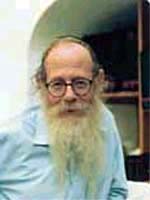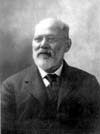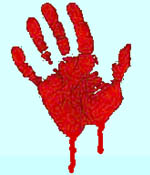
The Roadmap | ||||||||||||||||||||||||||||||||||||||||||||
|
The Talmud is a huge collection of doctrines and laws compiled and written before the 8th Century, A.D., by ancient Jewish teachers. The Talmud, which often cites the Old Testament, is the basic book of Jewish law. Babylonian and Palestinian TalmudsThere are two editions of the Talmud; one was composed by Babylonian Jews and one by Jews who lived in ancient Jerusalem. Generally a citation from the Talmud refers to the Babylonian version, which is considered authoritative. The Jerusalem Talmud is not generally taught in even the most Orthodox Jewish schools today, though advanced Talmud scholars sometimes study it. — Anti-Defamation League (12) (Note: Some say the "Jerusalem Talmud" should really be called the "Palestinian Talmud." [13]) Talmud PresentationThe material of the Talmud is presented as series of statements of principles and derivative discussions between the rabbinic Sages and schools of rabbinic Sages in the centuries preceding. Many of the discussions have no obvious sequence or context, leading to controversies among Talmudic scholars concerning the quality of its organization (see Is Talmud Law in Order or Disorder? [15]). Usually there is a paragraph or two of core doctrine (Mishnah), followed by dialog (Gemara) that expands and interprets the Mishnah. (14) The Talmud is organized into six major orders, called Seders, and each Seder is organized into a number of books ("tractates"), comprising 63 tractates in all and more than four million words. The Sages of the Talmud were teachers, judges, and sometimes priests of the Temple. Their legal decisions had the power of life and death over the Jewish people. Soncino Talmud
The Soncino Press Babylonian Talmud was the first complete English translation. It was translated into English under the editorship of Rabbi Dr. Isidore Epstein of Jews' College, London. The 63 tractates were translated by the leading rabbinical scholars of the day, and the final work was praised by many prominent rabbinical authorities, including two successive Chief Rabbis of the British Commonwealth. Each of the six Seders was published individually as it became available in the years between 1935 and 1948. See also Kudos for Soncino. Each tractate includes an introduction by the translator, a running commentary of extensive footnotes, a scriptural index, a glossary, and an index of words and subjects. In 1952, the individual indices were compiled, the Rabbinic Index was added, and the collection was published as a separate volume. (29) In 1961, the full set — containing all six seders, all 63 tractates, and the General Index — was republished without copyright notice on fine paper in 18 volumes. Pictured on the right is the author's copy of the 1961 edition, containing almost six million words. A number of the tractates from the author's copy have been transcribed into hypertext and appear on the Come and Hear™ website. Learn how this hypertext copy has been organized in Structure of the Talmud. Later, Soncino cut and pasted the original galleys into a larger format and republished the volumes with Hebrew and English on facing pages. Ancient RootsAccording to Talmud scholars, the Talmud is the written form of the teachings of the Pharisees — the very sect of Jewish priests with whom Jesus of Nazareth argued. Consider this passage from the translator of New Edition of the Babylonian Talmud and author of the History of the Talmud, Rabbi Michael Rodkinson:
— Rabbi Michael L. Rodkinson (1) Or consider this from The Universal Jewish Encyclopedia, in the entry "Pharisees": The Jewish religion as it is today traces its descent, without a break, through all the centuries, from the Pharisees. — R. Travers Herford for the Universal Jewish Encyclopedia. (2) Rabbi Dr. Louis Finkelstein, Instructor of Talmud, and later president of the Jewish Theological Seminary of America, writes:
— Rabbi Dr. Finkelstein (3) Thus, perhaps, we can understand some of the tension that has historically existed between Christianity and Judaism. According to the New Testament of the Bible, Jesus of Nazareth expressed strong personal feelings about the Pharisees in the following words:
Modern Significance of the TalmudMany famous Jewish religious and secular writers have commented on the role of the Talmud in modern Judaism. We have met some of these writers in What We're About. Rabbi Adin Even Israel Steinsaltz is the founder of the Israel Institute for Talmudic Publications, and has enjoyed the backing of Israeli presidents and prime ministers; he is a recipient of Israel's highest civilian honor, the Israel Prize. He is currently translating the Talmud into English, French, and Russian. In 1976, he writes: If the Bible is the cornerstone of Judaism, then the Talmud is the central pillar, soaring up from the foundations and supporting the entire spiritual and intellectual edifice. In many ways the Talmud is the most important book in Jewish culture, the backbone of creativity and of national life. No other work has had a comparable influence on the theory and practice of Jewish life, shaping spiritual content and serving as a guide to conduct. — Rabbi Steinsaltz (7) Herman Wouk is a Pulitzer Prize-winning author of 11 novels, three plays and two works of nonfiction. In his book, This is My God; the Jewish Way of Life, serialized in the New York Herald-Tribune in 1959, he writes: The Talmud is to this day the circulating heart's blood of the Jewish religion. Whatever laws, customs or ceremonies we observe — whether we are Orthodox, Conservative, Reform or merely spasmodic sentimentalists — we follow the Talmud. It is our common law. — Herman Wouk (8) Rabbi Dr. Jacob Neusner is Research Professor of Religion and Theology at Bard College and Senior Fellow of the Institute of Advanced Theology at Bard as well. He also is a Member of the Institute for Advanced Study, Princeton NJ, and Life Member of Clare Hall, Cambridge University, in England. He has published more than 850 books and numerous articles, both scholarly and academic and popular and journalistic, and is the most published humanities scholar in the world. (9) In 1990, Rabbi Dr. Neusner writes: The Bavli [Babylonian Talmud] has formed the definitive statement of Judaism from the time of its closure to the present day. — Rabbi Dr. Neusner (9) For a useful overview of the Talmud, see the InfoPlease.com definitions. (11)
Thank you for your consideration of the above,
NEXT: The Roadmap 2: Structure of the Talmud Files
Endnotes:
| |||||||||||||||||||||||||||||||||||||||||||
Footnotes:
Full specifics for each of the printed sources are provided in the Bibliography. Outside URLs were valid at the time this article was written. However, be mindful that URLs do change.
- The History of the Talmud, Vol. II, page 70 available at http://www.come-and-hear.com/talmud/rodkin_ii3.html#p70
- R. Travers Herford, writing for The Universal Jewish Encyclopedia, s.v. Pharisees, Volume 8, page 474, available at http://www.come-and-hear.com/uje/uje_474.html
- The Pharisees: The Sociological Background of Their Faith, page xxi, available at http://www.come-and-hear.com/talmud/finkelstein.html#xxi
- For more New Testament reportage on the conflicts between Jesus of Nazareth and the Pharisees, see also Matthew 23, John 8, John 18, and Matthew 27. For analysis and discussion, see The Jewish Religion: Its Influence Today, Chapter III (available at http://www.come-and-hear.com/dilling/chapt03.html). From there, use the hot links on Dilling's cites as entry points into Tractate Sanhedrin to see the Pharisee view on the accusations against Jesus, his trial, and his sentence
- "Jewish Theological Seminary of America," Graciano Corporation, http://www.graciano.com/jtheo_seminary.htm
- "Talmud and Rabbinics," JTS, http://www.jtsa.edu/academics/tal/index.shtml
- The Essential Talmud, page 3
- This is My God; the Jewish Way of Life by Herman Wouk as quoted by Elizabeth Dilling in The Jewish Religion: Its Influence Today, page 2 available in Come and Hear™ hypertext as http://www.come-and-hear.com/dilling/chapt01.html#page_2
- Rabbi Dr. Jacob Neusner, quoted by Norman F. Cantor, The Sacred Chain (A History of the Jews), page 112. Bio available at http://inside.bard.edu/religion/faculty.shtml cached at http://www.come-and-hear.com/editor/neusner-bio/index.html#neusner
- Herschel Revel, Librarian of the Isaac Elchanan Theological Seminary, New York, writing for The Universal Jewish Encyclopedia, s.v. "Talmud," Volume 10, page 165
- InfoPlease.com http://infoplease.com/ipd/A0686084.html cached at: http://www.come-and-hear.com/editor/talmud-infoplease-def/index.html
and the encyclopedia entry on the same subject at http://www.infoplease.com/ce6/society/A0847727.html
cached at http://www.come-and-hear.com/editor/talmud-infoplease- The Talmud in Anti-Semitic Polemics, Anti-Defamation League, February 2003, http://www.adl.org/presrele/asus%5F12/the_talmud.pdf
- "Foreword," The Babylonian Talmud, Seder Nezikin, Vol. I, page xx available at http://www.come-and-hear.com/talmud/nezikin_h.html#xx
- For more explanation of these terms, see Critical Words of Talmud Study and More Critical Words of Talmud Study at http://www.come-and-hear.com/editor/critwords_1.html and http://www.come-and-hear.com/editor/critwords_2.html respectively
- "Is Talmud Law in Order or Disorder?" is found at http://www.come-and-hear.com/editor/ordchaos.html
© Copyright Carol A. Valentine, 2003. See copyright statement at http://www.come-and-hear.com/copyright.html
NEXT: The Roadmap 2: Structure of the Talmud Files
| Navigate This Site | |
 | |
| Home | |
| Valentine | |
| Dilling | |
| Talmud | |
| The Rabbis | |
| Supplement | |
| Glossary | |
| Download | |
| Admin | |
| | |







 Genuine Come and Hear™ CDs do not contain executable programs. When making CDs, do not include any files that end in .exe, .com, .bat, .vbs, .doc, .pif, .sit, or .scr. The person receiving the CD should use his own browser to view the files. This helps to protect him from harmful programs and viruses.
Genuine Come and Hear™ CDs do not contain executable programs. When making CDs, do not include any files that end in .exe, .com, .bat, .vbs, .doc, .pif, .sit, or .scr. The person receiving the CD should use his own browser to view the files. This helps to protect him from harmful programs and viruses. 
 Is the literature that Jesus was familiar with in his early years yet in existence in the world? Is it possible for us to get at it? Can we ourselves review the ideas, the statements, the modes of reasoning and thinking, on moral and religious subjects, which were current in his time, and must have been [resolved] by him during those silent thirty years when he was pondering his future mission? To such inquiries the learned class of Jewish rabbis answer by holding up the Talmud. Here, say they, is the source from whence Jesus of Nazareth drew the teaching which enabled him to revolutionize the world; and the question becomes, therefore, an interesting one to every Christian, What is the Talmud? …
Is the literature that Jesus was familiar with in his early years yet in existence in the world? Is it possible for us to get at it? Can we ourselves review the ideas, the statements, the modes of reasoning and thinking, on moral and religious subjects, which were current in his time, and must have been [resolved] by him during those silent thirty years when he was pondering his future mission? To such inquiries the learned class of Jewish rabbis answer by holding up the Talmud. Here, say they, is the source from whence Jesus of Nazareth drew the teaching which enabled him to revolutionize the world; and the question becomes, therefore, an interesting one to every Christian, What is the Talmud? …  Pharisaism became Talmudism, Talmudism became Medieval Rabbinism, and Medieval Rabbinism became Modern Rabbinism. But throughout these changes of name, inevitable adaptation of custom, and adjustment of Law, the spirit of the ancient Pharisee survives unaltered. When the Jew reads his prayers, he is reciting formulae prepared by pre-Maccabean scholars; when he dons the cloak prescribed for the Day of Atonement and Passover Eve, he is wearing the festival garment of ancient Jerusalem; when he studies the Talmud, he is actually repeating the arguments used in the Palestinian academies.
Pharisaism became Talmudism, Talmudism became Medieval Rabbinism, and Medieval Rabbinism became Modern Rabbinism. But throughout these changes of name, inevitable adaptation of custom, and adjustment of Law, the spirit of the ancient Pharisee survives unaltered. When the Jew reads his prayers, he is reciting formulae prepared by pre-Maccabean scholars; when he dons the cloak prescribed for the Day of Atonement and Passover Eve, he is wearing the festival garment of ancient Jerusalem; when he studies the Talmud, he is actually repeating the arguments used in the Palestinian academies.




